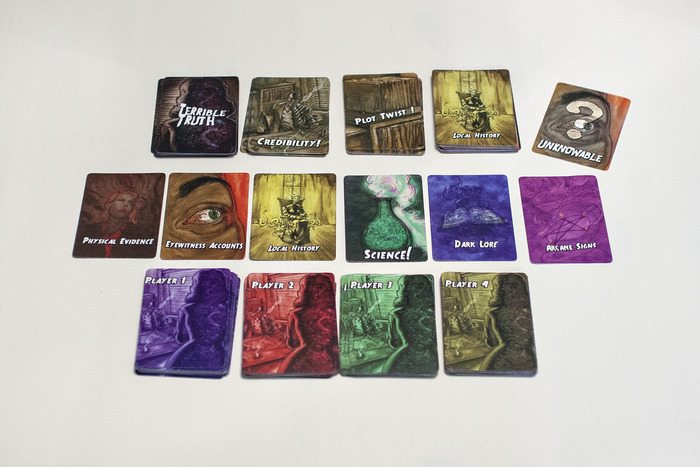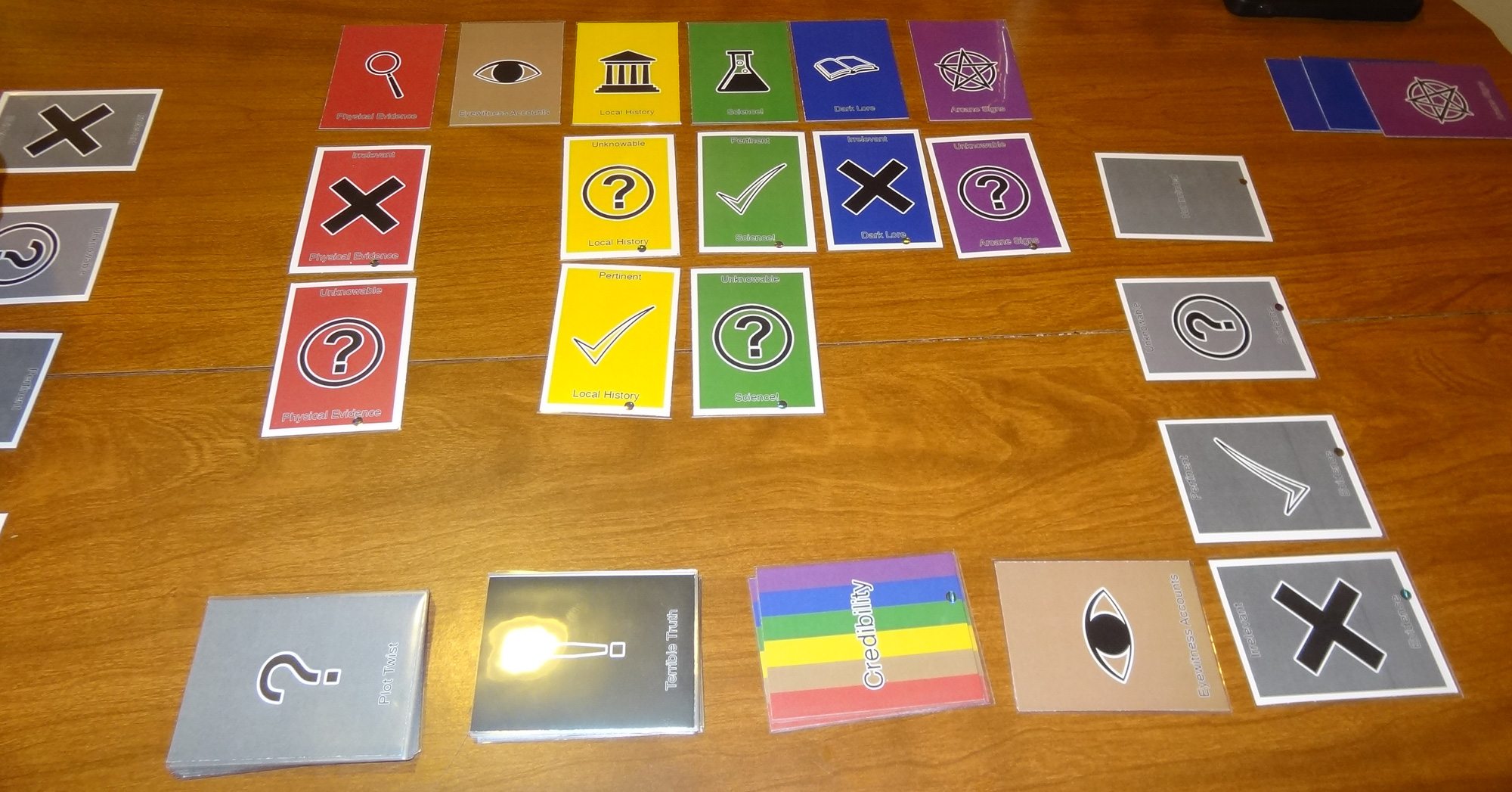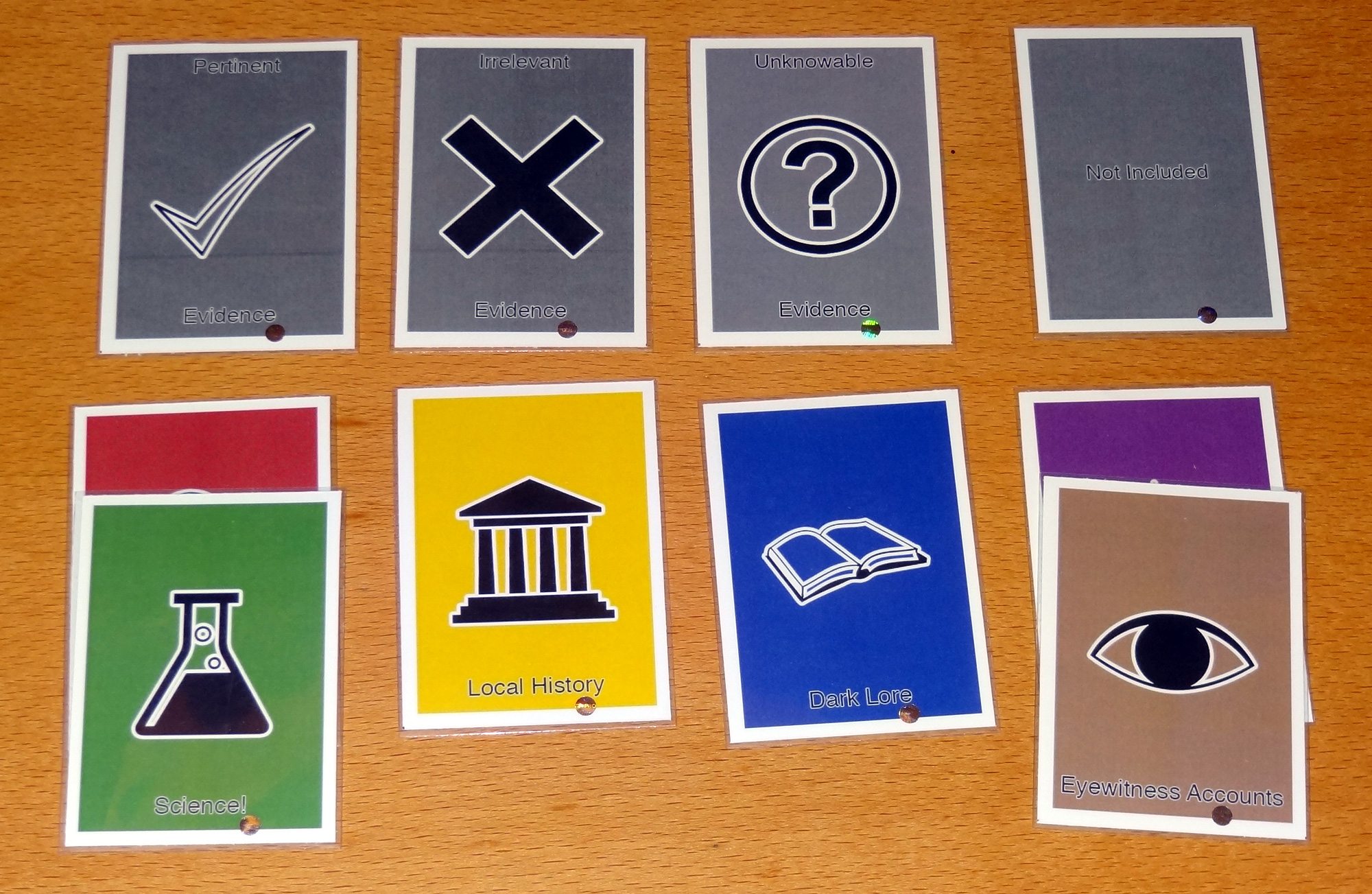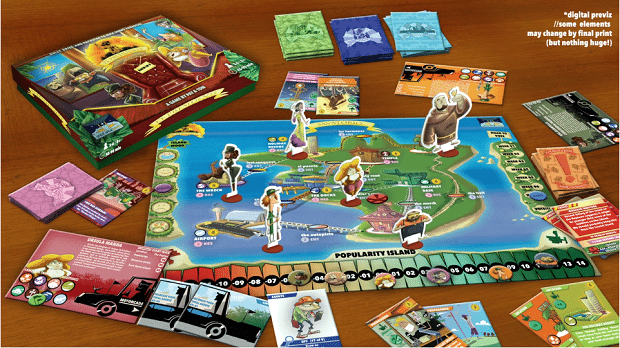The world is full of mysteries, but you and your fellow investigators are on the case. Each case might involve local history, eyewitness accounts, and other evidence—but not everything is pertinent to the case. And, of course, there are some Truths Too Terrible to know.
At a glance: Truths Too Terrible is a deduction game for 2 to 4 players, ages 10 and up, and takes about half an hour to play. The basic pledge level for a copy of the game is $14 (shipped to the US; international shipping costs extra). I think based on the game mechanics and the artwork that 10 and up is about right.
New to Kickstarter? Read our crowdfunding primer.

Components:
- 40 Solution cards
- 24 Evidence cards
- 20 Plot Twist cards
- 8 Terrible Truth cards
- 6 Credibility cards
- 1 Lead Investigator card
- 7 rules cards
I tried a demo prototype that had placeholder artwork only; the photo above shows artwork in a more completed state, and it’s looking pretty good, with lots of creepy motifs throughout. As you can see, the game is entirely card-based, and the cards for the most part carry only a few pieces of information so there’s not a lot of reading of cards for effects.
There are 6 types of evidence: Physical Evidence, Eyewitness Accounts, Local History, Science, Dark Lore, and Arcane Signs. Each type has 4 cards associated with it: 1 Pertinent, 1 Irrelevant, and 2 Unknowable.
The Plot Twist cards have a little flavor text and then some effect that changes the rules for a round. For instance, it might require that you include Eyewitness Accounts in your case, or restrict the types of Dirty Tricks you can use. Some Plot Twist cards actually have no effect and are just flavor text.
How to play
The goal of the game is to be the first to learn 3 Terrible Truths by correctly identifying the various types of evidence as pertinent, irrelevant, or unknowable.
Each player gets a set of 10 Solution cards: it has one card for each type of evidence, and then four other cards: Pertinent, Irrelevant, Unknowable, or Not Included. These are used to present your case at the end of the round. The Evidence cards are all shuffled together, and then one of each type is dealt out face-down on the table. (Just skip repeats and shuffle them back in after setup). Finally, the top three cards of the Evidence deck are set out in another area (also face-down) as the available Investigations.

Your goal is to figure out as many of these six cards as possible. For instance, you might have Physical Evidence and Arcane Signs as Pertinent, Local History as Irrelevant, and the rest as Unknowable.
On your turn, you get one of these actions: Investigate, Play a Dirty Trick, or Present the Case.
To Investigate, you choose one of the available Investigation cards and either do a public or private Investigation. If it’s public, you flip it face-up, placing it next to the matching Evidence type, and then take a Credibility card. If it’s private, you take it, look at it secretly, and keep it face-down in front of you. (You can look at your own private Investigations at any time.) After your Investigation, the next Evidence card is drawn to replace it.
To Play a Dirty Trick, you must have Credibility. You return a Credibility to the supply, and then choose one of the following:
- Consult the Arcane: Choose a type of Evidence that does not currently have an available Investigation—look for a card of that type in the Evidence deck and take it like a private Investigation.
- Expose Their Lies: Choose somebody else’s Private Investigation card, and reveal it like a public Investigation.
- Glimpse the Forbidden: Choose an available Investigation, look at it privately, and then set it aside for the rest of the round. Nobody (including you) may look at it again for the rest of the round.
Finally, if you think you’ve got things figured out, you can Present the Case. If there are no Investigations left, you must choose to Present the Case. Each player simultaneously sorts their 6 evidence types into the four piles: Pertinent, Irrelevant, Unknowable, or Not Included—the last choice means that you don’t want to guess. The goal is to have the most correct answers with no wrong answers.

Once everyone has sorted their evidence, everyone reveals their cases, and the six face-down Evidence cards are revealed as well. Whoever has the most correct answers and no incorrect answers claims a Terrible Truth card. (Ties go to the player farthest from starting player.)
For subsequent rounds, the Evidence cards are all reshuffled, the winner of the round becomes starting player, and everyone discards their Credibility to the supply (except for the player with the most, who keeps 1). You’ll also start revealing Plot Twist cards after the first round, following the instructions on them.
The first player to collect three Terrible Truths wins.
The Verdict
Truths Too Terrible reminds me a little bit of the classic deduction game Clue, since you’re looking for answers through the process of elimination. If you find a Pertinent Local History card during your investigations, you now know that Local History must be either Irrelevant or Unknowable.
However, there are a couple of twists that mix things up. For one thing, there’s no board, but the board in Clue was more of a formality anyway—it was really all about the deduction. More importantly, there are two “Unknowable” cards of each evidence type, so just because you’ve seen one doesn’t mean that you can be sure of the answer. On the other hand, if you manage to find the Pertinent and Irrelevant card, then you can say with certainty that the solution is Unknowable.
The other twist, of course, is the Dirty Tricks. Turning somebody’s private Investigation into a public one may help other players as much as you, but it might give you the crucial piece of a solution. The Glimpse the Forbidden trick is nice because it lets you peek at a card and then nobody else can do anything to that card—however, if your memory isn’t strong, you may forget what you saw. It’s also interesting that the only way to play a Dirty Trick is to collect Credibility, which you do by giving everyone information. It’s a nice balancing trick, deciding when to reveal investigations to everyone and when to keep things to yourself.
An important part of the strategy is deciding when to Present the Case—ultimately you’ll want to choose that when you feel you’ve got better guesses than your opponents. You can always guess at the things you’re not sure about, but if you’re wrong about any of them, you can’t win the round. Timing is important, and it’s crucial to keep track of how many answers your opponents are likely to have figured out already.
I wasn’t entirely sure about the balance of the solutions: since there’s always a 50% chance that the answer is Unknowable, we did find that it was often a pretty good strategy to just dump all of your unsure cards into Unknowable rather than not including them, because either of the other answers was only a 25% chance if you had no information. On the other hand, the uneven probabilities do occasionally make for some curious situations that I found I liked.
The other thing I didn’t always like was that because there are only four cards for each evidence type, sometimes too many solutions were revealed publicly too soon, which made for less interesting rounds.
I did like having Plot Twists that changed up the rules during the round. The initial mix of Plot Twist cards had more that were flavor-only, but I was glad to hear that they’ve increased the number of Twists that actually, you know, twist things.
Overall, Truths Too Terrible can be a fun bit of deduction and bluffing. It’s not incredibly deep, but if you like the deduction and guesswork of games like Clue, this is a faster-paced game that retains some of that feel. I didn’t think the theme was entirely integral to the gameplay—it could probably easily be turned into a game about werewolves or pinatas—but the monster noir artwork does help tie it together.
For more about the game, visit the Truths Too Terrible Kickstarter page.




